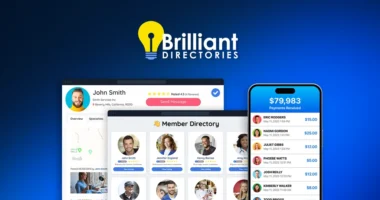Ecommerce order management software (OMS) centralizes and automates online retail operations across multiple sales channels. These systems handle everything from order processing and inventory tracking to shipping management and returns. Modern OMS solutions integrate with existing business tools while providing real-time analytics and AI-driven insights. Key features include automated order routing, multi-warehouse coordination, and seamless third-party logistics integration. Understanding these capabilities is essential for scaling an ecommerce business effectively.
Quick Overview
- Order management software centralizes e-commerce orders from multiple sales channels into one system for streamlined processing and fulfillment.
- Real-time inventory tracking prevents overselling by automatically synchronizing stock levels across all connected sales platforms.
- Automated workflows handle order routing, shipping label generation, and customer notifications to reduce manual tasks and errors.
- Integration capabilities connect with ERP systems, third-party logistics providers, and other business tools for seamless operations.
- Built-in analytics provide insights into order performance, sales channels, and inventory trends to optimize business decisions.
Understanding the Core Functions of Order Management Software

Every successful ecommerce business relies on order management software to streamline its operations and deliver excellent customer service. These systems integrate five essential functions that work together seamlessly to manage the entire order lifecycle.
The core functions include order entry and processing, which centralizes data from multiple sales channels and automates order creation. Inventory management tracks stock levels in real-time and prevents stockouts through automated alerts. Warehouse management optimizes picking routes and coordinates fulfillment activities across locations.
The shipping and logistics component handles carrier integration and delivery tracking, while the analytics function provides vital insights through detailed reporting. Customer service tools enable support teams to access complete order histories and status updates for informed assistance. Together, these components guarantee orders move smoothly from purchase to delivery, while maintaining accurate records and providing valuable business intelligence for decision-making.
Essential Features That Drive Order Processing Efficiency
Five essential features stand at the heart of efficient order processing software, transforming how businesses handle their daily operations. Real-time tracking provides instant visibility through unique codes and automated updates, while robust inventory management prevents costly stockouts by synchronizing levels across channels.
Multi-channel integration consolidates orders from various platforms into a single system, streamlining fulfillment and communication between partners. The integration of AI and machine learning helps optimize inventory allocation and predict fulfillment patterns.
Automated workflows eliminate manual tasks and reduce errors through customizable rules and bulk processing capabilities. These systems generate shipping labels and handle routine operations automatically.
Finally, thorough analytics deliver actionable insights through customizable dashboards, tracking key metrics like order fill times and return patterns. Together, these features create a seamless, data-driven approach to order management that enhances operational efficiency and customer satisfaction.
How Modern OMS Solutions Transform E-commerce Operations

Modern Order Management System (OMS) solutions are revolutionizing how e-commerce businesses operate, bringing unprecedented levels of efficiency and control to their operations. These systems transform traditional processes through automation, data analytics, and seamless integration across multiple channels. For businesses with complex fulfillment needs, implementing streamlined fulfillment coordination ensures faster delivery times and enhanced satisfaction.
| Transformation Area | Key Benefits |
|---|---|
| Order Processing | Automated routing, reduced errors |
| Customer Service | Real-time tracking, personalized experience |
| Inventory Management | Cross-channel visibility, precise forecasting |
| Business Intelligence | Data-driven decisions, actionable insights |
The impact of modern OMS extends beyond basic order processing, enabling businesses to scale operations efficiently while maintaining service quality. Through extensive analytics and automated workflows, companies can better predict demand, optimize inventory levels, and deliver superior customer experiences. This technological advancement particularly helps during peak seasons, when order volumes surge and operational efficiency becomes vital.
Selecting the Right Order Management System for Your Business
As businesses navigate the complex landscape of e-commerce solutions, selecting the right Order Management System (OMS) requires careful consideration of multiple factors.
The selection process begins with a thorough assessment of business needs, including current pain points, order volumes, and integration requirements. Decision-makers should evaluate key features like real-time inventory tracking, automated order routing, and returns management capabilities. An effective OMS must provide robust multichannel management capabilities to maintain consistent operations across all sales platforms.
Additionally, the system’s scalability and flexibility are essential factors, ensuring it can grow alongside the business.
Implementation ease and total cost of ownership also play important roles in the decision. A user-friendly interface promotes quick adoption, while understanding all associated costs – from setup fees to ongoing subscriptions – helps prevent unexpected expenses.
The ideal OMS should balance current operational needs with future growth potential, making it a sustainable investment for the business.
Best Practices for Implementing Order Management Software

Successful implementation of order management software requires a well-planned, systematic approach that encompasses several critical phases. Organizations must start by assembling a cross-functional team and establishing clear objectives and performance indicators for the implementation process.
The next steps involve careful system configuration, data migration, and integration with existing platforms. Teams should tailor the OMS to match business needs without modifying the core software, while guaranteeing seamless connections with ecommerce platforms and warehouse systems. Implementing intelligent workflow designs helps streamline operations and maximize efficiency during the integration process. Thorough testing across all components is essential, including unit testing and high-volume scenario simulations.
Finally, extensive training materials and phased deployment help minimize disruption. Staff must receive proper training on new features and processes, while ongoing support and performance monitoring secure a smooth shift to the new system.
Future-Proofing Your Business With Advanced OMS Technology
Digital transformation pioneers are revolutionizing order management through advanced technology adoption that safeguards business longevity. Modern OMS platforms integrate AI, blockchain, and smart robotics to create resilient, future-ready operations. Implementing these systems can lead to a 32% reduction] in operational costs through enhanced automation and efficiency.
Key technological advances enabling future-proof OMS include:
- AI-powered demand forecasting, reducing stockouts by up to 25%
- Smart warehousing solutions with IoT sensors and robotics
- Unified commerce platforms that seamlessly connect online and offline channels
- Blockchain technology for enhanced supply chain transparency
- Microservices architecture for rapid adaptation to market changes
With ecommerce sales projected to reach $8 trillion by 2026, businesses must embrace these innovations to stay competitive. Integration of WMS, OMS, and shipping platforms creates a single source of truth, while AI-driven tools like Pipe17’s Pippen automate complex operations for sustained growth.
Frequently Asked Questions
How Long Does It Typically Take to Train Staff on OMS?
Training staff on OMS typically takes 1-2 weeks for basic functions and 2-3 months for full proficiency. The timeline varies based on several factors:
- System complexity
- Staff’s prior experience
- Organization size
- Integration requirements
Basic training covers essential functions in 1-2 weeks, while advanced features require 4-8 weeks. Most organizations implement a phased approach, starting with core features before progressing to complex functionalities.
Ongoing training is necessary for updates and new features.
Can OMS Handle Multiple Currencies and International Tax Regulations?
Modern OMS platforms are well-equipped to handle multiple currencies and international tax regulations. They offer real-time currency conversion and automatic tax calculations based on customer location. In addition, these systems support various tax systems like VAT and GST.
These capabilities enable OMS platforms to manage pricing in different currencies, track exchange rate fluctuations, and guarantee compliance with local tax laws. Most platforms also provide multi-currency reporting and can handle complex international transactions seamlessly.
What Happens to Order Management During System Maintenance or Downtime?
Studies show that e-commerce businesses lose an average of $4,000 per hour during system downtime. During maintenance or outages, order management typically experiences several key disruptions. New orders may be temporarily halted, creating a backlog that requires careful processing once systems resume.
Real-time inventory updates pause, risking overselling. Companies often implement manual processing procedures and proactive customer communication strategies. Recovery involves systematic backlog processing and thorough data reconciliation to guarantee accuracy.
Are There Industry-Specific OMS Solutions for Niche Product Categories?
Yes, specialized OMS solutions exist for distinct product categories, each tailored to meet unique industry requirements. Fashion and apparel systems focus on size/color variants and virtual fitting integration, while food and beverage solutions prioritize perishable inventory and temperature control.
Electronics OMS emphasizes warranty tracking and software management, and luxury goods systems feature authentication tracking and white-glove delivery options. These specialized systems guarantee the best handling of industry-specific challenges.
How Frequently Should Businesses Upgrade Their Order Management Software?
Businesses should evaluate their order management software quarterly and conduct thorough reviews annually. Generally, growing companies benefit from major upgrades every 2-3 years, while smaller, stable operations may extend this to 3-4 years.
However, immediate upgrades are necessary if the current system shows performance issues, lacks essential features, or cannot handle increased order volumes. Regular incremental updates should be implemented as new features become available to maintain superior functionality.
Conclusion
Order management software has evolved from simple transaction tools into mission-critical systems that can process a million orders faster than a cheetah chasing its prey. As e-commerce continues to reshape retail, businesses that implement robust OMS solutions position themselves for sustainable growth and operational excellence. By carefully selecting and deploying the right system, companies can streamline operations, delight customers, and maintain a competitive edge in the digital marketplace.








